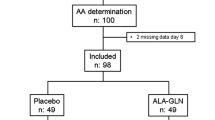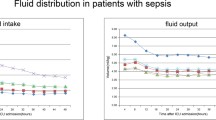Abstract
The aim of this study was to compare several parameters of GH/IGF-I axis activity in septic and trauma patients during Intensive Care Unit (ICU) stay. To this goal, 13 patients with sepsis (SEP) and 16 with trauma (TRA) were studied. Thirty-three adult subjects (AS) were studied as controls. Serum IGF-I and -II, IGFBP-1, -2 and -3, GH and GHBP levels were studied on day 1, 3, 5 and 7 after ICU admission, during comparable artificial nutrition in SEP and TRA and basally in AS. In 5 patients with SEP and 6 with TRA, the GH response to GHRH was evaluated on day 3. On ICU day 1, IGF-I and -II and IGFBP-3 in SEP were lower (p<0.05) than in TRA which, in turn, were lower (p<0.01) than in AS. IGF-I increased (p<0.05) both in SEP and TRA, but, on ICU day 7, those in SEP persisted lower than in TRA, which became similar to those in AS. IGF-II levels increased (p<0.05) in SEP only, persisting lower (p<0.05) than in TRA. On ICU day 1, GH in SEP and TRA were similar and did not vary until day 7, overlapping those in AS. The GH response to GHRH in SEP and TRA was similar and lower (p<0.01) than in AS. These findings indicate that IGF-I activity is impaired more in septic than in trauma patients. Reduced IGF-I activity probably reflects peripheral GH resistance though basal and GHRH-induced GH levels were not increased in these conditions.
Similar content being viewed by others
References
Wilmore D.W. Catabolic illness. N. Engl. J. Med. 1991, 325: 695–702.
Jenkins R.C., Ross R.J.M. The endocrinology of the critically ill. Curr. Opin. Endocrinol. 1996, 3: 138–145.
Van den Berghe G., de Zegher F. Anterior pituitary function during critical illness and dopamine treatment. Crit. Care Med. 1996, 24: 1580–1590.
Van den Berghe G., de Zegher F., Lauwers P., Veldhuis J.D. Growth hormone secretion in critical illness: effect of dopamine. J. Clin. Endocrinol. Metab. 1994, 79: 1141–1146.
Ross R.J.M., Chew S.L. Acquired growth hormone resistance. Eur. J. Endocrinol. 1995, 132: 655–660.
Faber J., Kirkegaard C., Rasmussen B. et al. Pituitary-thyroid axis in critical illness. J. Clin. Endocrinol. Metab. 1987, 65: 315–320.
Thissen J.P., Ketesleger J.M., Underwood L.E. Nutritional regulation of Insulin-like growth factors. End. Rev. 1994, 15: 80–85.
Ketelslegers J.M., Maiter D., Maes M., Underwood L.E., Thissen J.P. Nutritional regulation of the growth hormone and insulin-like growth factor-binding proteins. Horm. Res. 1996, 45: 252–257.
Abribat T., Brazeau P., Davignon I., Garrel D.R. Insulin-like growth factor-I blood levels in severely burned patients: effects of time post injury, age of patient and severity of burn. Clin. Endocrinol. (Oxf.) 1993, 39: 583–589.
Dahn M.S., Lange M.P., Jacobs L.A. Insulin-like growth factor-I production is inhibited in human sepsis. Arch. Surg. 1988, 123: 1409–1414.
Cotterill A.M., Mendel P., Holly J.P.M., et al. The differential regulation of the circulating levels of the insulin-like growth factors and their binding proteins (IGFBP) 1, 2 and 3 after elective abdominal surgery. Clin. Endocrinol. (Oxf.) 1996, 44: 91–101.
Timmins A.C., Cotterill A.M., Cwylan Hughes S.C., et al. Critical illness is associated with low circulating concentrations of insulin-like growth factors-I and -II, alterations in insulin-like growth factor binding proteins, and induction of an insulin-like growth factor binding protein 3 protease. Crit. Care Med. 1996, 24: 1460–1466.
Gianotti L., Broglio F., Aimaretti G., et al. Low IGF-I levels are often uncoupled with elevated GH levels in catabolic conditions. J. Endocrinol. Invest. 1998, 21: 115–121.
Belcher H.J.C.R., Mercer D., Judkins K.C., et al. Biosynthetic human growth hormone in burned patients: a pilot study. Burns 1989, 15: 99–107.
Fleming R.Y.D., Rutan R.L., Jahoor F., et al. Effect of recombinant human growth hormone on catabolic hormones and free fatty acids following thermal injury. J. Trauma 1992, 32: 698–703.
Voerman H.J., Strack van Schijndel R.J.M., Groeneveld A.B.J., et al. Effects of recombinant human growth hormone in patients with severe sepsis. Ann. Surg. 1992, 216: 648–651.
Ross R.J.M., Miell J., Freeman E., et al. Critically ill patients have high basal growth hormone levels with attenuated oscillatory activity associated with low levels of insulin-like growth factor-I. Clin. Endocrinol. (Oxf.) 1991, 35: 47–54.
Jeevanandan M., Holaday N.J., Petersen S.R. Plasma levels of insulin-like growth factor binding protein-3 in acute trauma patients. Metabolism 1995, 44: 1205–1208.
Ziegler T.R., Romeau J.L., Young L.S., et al. Recombinant human growth hormone enhances the metabolic efficacy of parenteral nutrition: a double-blind, randomized controlled study. J. Clin. Endocrinol. Metab. 1992, 74: 865–873.
Byrne T.A., Morissey T.B., Gatzen C., et al. Anabolic therapy with growth hormone accelerates protein gain in surgical patients requiring nutritional rehabilitation. Ann. Surg. 1993, 218: 400–418.
Mulligan K., Grunfeld C., Hellerstein M.K., Neese R.A., Schambelan M. Anabolic effects of recombinant human growth hormone in patients with wasting associated with human immunodeficiency virus infection. J. Clin. Endocrinol. Metab. 1993, 77: 956–962.
Vara-Thorbeck R., Ruiz-Requena E., Guerrero-Fernandez J.A. Effects of human growth hormone on the catabolic state after surgical trauma. Horm. Res. 1996, 45: 55–60.
Frost R.A., Fuhrer J., Steigbigel R., et al. Wasting in the acquired immune deficiency syndrome is associated with multiple defects in the serum insulin-like growth factor system. Clin. Endocrinol. (Oxf.) 1996, 44: 501–514.
Nygren J., Sammann M., Malm M., et al. Disturbed anabolic hormonal patterns in burned patients: the relation to glucagon. Clin. Endocrinol. 1995, 43: 491–500.
Jeffries M.K., Lee Vance M. Growth hormone and cortisol secretion in patients with burn injury. J. Burn Care Rehabil. 1992, 13: 391–395.
Voerman H.J., Groeneveld A.B.J., de Boer H., et al. Time course and variability of the endocrine and metabolic response to severe sepsis. Surgery 1993, 114: 951–959.
Melarvie S., Jeevanandam M., Holaday N.J., Petersen S.R. Pulsatile nature of growth hormone levels in critically ill trauma victims. Surgery 1995, 117: 402–408.
Heijligenberg R., Sauerwein H.P., Brabant G., et al. Circadian growth hormone secretion in asymptomatic human immune deficiency virus infection and acquired immunodeficiency syndrome. J. Clin. Endocrinol. Metab. 1996, 81: 4028–4032.
Casanueva F.F., Villanueva L., Dieguez C., et al. Free fatty acids block growth hormone (GH) releasing hormonestimulated GH secretion in man directly at the pituitary. J. Clin. Endocrinol. Metab. 1987, 65: 634–642.
Casanueva F.F. Physiology of growth hormone secretion and action. In: Melmed S. (Ed.), Acromegaly Endocrinology and Metabolism. Clin. North Am. 1992, 21: 483–517.
Ghigo E. Neurotransmitter control of growth hormone secretion. In: De la Cruz L.F. (Ed.), Regulation of growth hormone and somatic growth. Elsevier Science Publishers, Amsterdam, 1992, pp. 103–136.
Ghigo E., Arvat E., Muccioli G., Camanni F. Growth hormone (GH)-releasing peptides. Eur. J. Endocrinol. 1997, 136: 445–460.
Van den Berghe G., de Zegher F., Bowers C.Y., et al. Pituitary responsiveness to GH-releasing peptide-2 and thyrotropin-releasing hormone in critical illness. Clin. Endocrinol. (Oxf.) 1996, 45: 341–351.
Donaghy A., Ross R.J.M., Gimson A., et al. Growth hormone, insulin-like growth factor-I, and insulin-like growth factor binding proteins 1 and 3 in chronic liver disease. Hepatology 1995, 21: 680–688.
Takala J., Keinänen O., Vaisanen P., Kari A. Measurement of gas exchange in intensive care: Laboratory and clinical validation of a new device. Crit. Care Med. 1989, 17: 1041–1047.
Jones J., Clemmons D.R. Insulin-like growth factors and their binding proteins: biological actions. Endocr. Rev. 1995, 16: 3–34.
Froesch E.R., Zenobi P.D., Hussain M. Metabolic and therapeutic effects of insulin-like growth factor I. Horm. Res. 1994, 42: 66–71.
Donahue S.P., Phillips L.S. Response of IGF-I to nutritional support in malnourished hospital patients: a possible indicator of short-term changes in nutritional status. Am. J. Clin. Nutr. 1989, 50: 962–969.
Haymond M.W., Mauras N. The rationale for the use of recombinant human growth hormone and insulin-like growth factor-I for catabolic conditions in humans. Horm. Res. 1996, 46: 202–207.
Bauman G., Shaw M.A., Amburn K. Circulating growth hormone binding proteins. J. Endocrinol. Invest. 1994, 17: 67–81.
Weissman C., Kemper M., Elwyn D.H., et al. The energy expenditure of the mechanically ventilated critically ill patient. Chest 1986, 89: 254–259.
Golden M.H.N. Transport proteins as indices of protein status. Am. J. Clin. Nutr. 1982, 35: 1159–1165.
Imura H., Fukata J., Mori T. Cytokines and endocrine function: an interaction between the immune and neuroendocrine systems. Clin. Endocrinol. (Oxf.) 1991, 35: 107–115.
Blackwell T.S., Christamn J.W. Sepsis and cytokines: current status. Pr. J. Anaesth. 1996; 77: 110–117.
Ingenbleek Y., De Visscher M., De Nayer P. Measurement of prealbumin as index of protein-calorie malnutrition. Lancet 1972, II: 106–108.
Ingenbleek Y., Van Den Schriech H.G., De Nayer P., De Visscher M. The role of retinol-binding protein in proteincalorie malnutrition. Metabolism 1975, 24: 633–641.
Hartman M.L., Faria A.C.S., Vance M.L. et al. Temporal structure of in vivo growth hormone secretory events in humans. Am. J. Physiol. 1991, 260: E101–E105.
Author information
Authors and Affiliations
Corresponding author
Rights and permissions
About this article
Cite this article
Pittoni, G., Gallioli, G., Zanello, M. et al. Activity of GH/IGF-I axis in trauma and septic patients during artificial nutrition: Different behavior patterns?. J Endocrinol Invest 25, 214–223 (2002). https://doi.org/10.1007/BF03343993
Accepted:
Published:
Issue Date:
DOI: https://doi.org/10.1007/BF03343993




